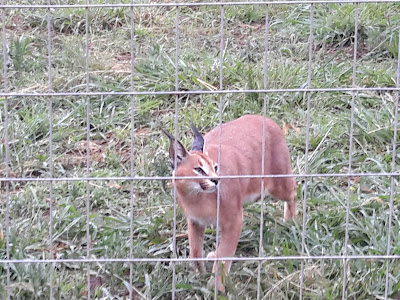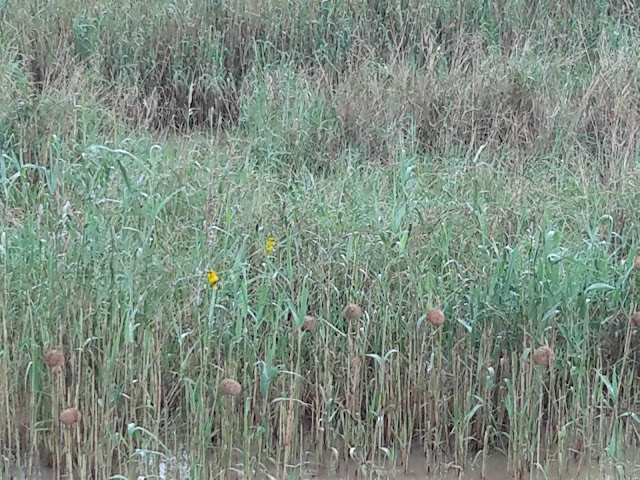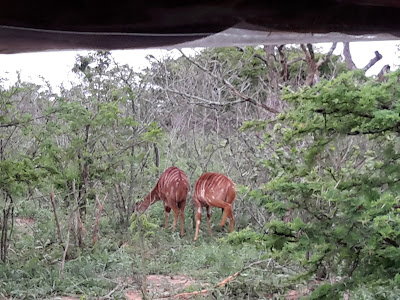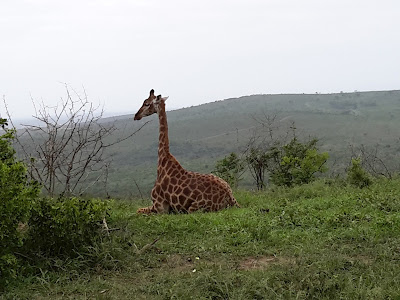RICHARDS BAY AND DURBAN, SOUTH AFRICA
OCTOBER 26 – NOVEMBER 13, 2016
We arrived
off Richards Bay jetty at 1148 hrs on Oct. 26, 2016 and were secured at
TuziGazi marina at 1224 hrs. After the
gale force winds we had off Cape St. Lucia, the winds continued in the South at
10-15 kts. We had about 40 nm to go and
I didn’t want to get there too early so, rather than motor, we put in a series
of tacks to arrive off the port. I
always prefer sail power over the engine.
Richards Bay
is the largest coal port in the world.
Just to the south of the port, there may be more than forty vessels
anchored waiting to load. What this
means to a yacht entering or leaving is that it will have to wait until Port
Control gives permission and the channel is clear. There are two marinas in Richards Bay: TuziGazi & The Royal Zululand Yacht Club
(28-47.576’ S; 032-05.010’ E). In order
to clear in with the authorities, one has to go to TuziGazi. This marina was devastated by a bad storm
last year that caused many of the pontoons to drag and collapse. Many yachts suffered damage. Although it is still operating as if nothing
had happened, most of the pontoons are bare metal with very little fendering. Added to that, they are charging too much
money for non-existent facilities. The
Royal Zululand Yacht Club is totally different.
It is one of the friendliest and most welcoming Yacht Clubs in the
world. On arrival they give you a free
bottle of “bubbly” and a berth for two weeks without charge. The surroundings
are beautiful and they have haul out facilities, a chandlery, and general
repairs. A yacht can get just about
anything done in Richards Bay.
Reputedly, it is a little cheaper for repairs than Durban, which is a
2-1/2 hour drive to the South. Depending
on the repairs, some of technicians may have to come from Durban which would
offset any savings realized.
During our
stay at the ZLYC, we were advised that the WORLD ARC RALLEY would be arriving
on November 9th and all berths had to be vacated to make room for
them. Accordingly, we departed on ZLYC
at 1500 hrs on November 7th for Durban which is about eighty-five nm
to the South. We had a 10-15 kt NE’ly
wind which put it almost on our stern, so we poled out the genoa and sailed
under that. It was a rolly trip and the
winds picked up to 20+ kts at times but we made good progress and arrived off
the Durban jetties at 0812 hrs in the morning.
A berth had been arranged at the Durban Marina so we went right in and
were all fast at 0900 hrs. Within two
hours, the S’ly verred into the SW and blew like stink (35 kts). We were fortunate to have made it just in
time. That is what makes the African
East Coast so difficult to navigate.
Richards Bay
is one big shopping center with a coal loading terminal. It was exciting to be back in a first world
country. This is meat eating country and
the portions are hugh. They still have
bonifide butchers cutting all sorts of beautiful and exotic meats. Next to Stateside quality they are just as
good, if not better, and cheap. A t-Bone
or Porterhouse steak, big enough for two, is about $5 US. Pork and Lamb follow suite and quite
affordable. In general, food is very
reasonable.
South
Africans are a warm, welcoming, generous and friendly people. They will strike up a conversation whenever
they can. The yachting fraternity is
most helpful and will do everything they can to assist in solving a
problem. The beauty of Richards Bay is
that it is strategically located near one of the National Parks: Hluhluwe (sloo-sloo-we); I don’t know how
they get that pronunciation but it’s Zulu. We rented a car with our cruising friends and
drove to Cape St Lucia which was and has
the largest population of white and black rhino. It was from this park that ”Operation Rhino”
started and has brought the rhinos back from the brink of extinction. It is only one and one half hours away from Richards Bay. We made arrangements to take a day safari
through the northern half of the park.
The tour operators pick you up at the rooming house at 0500 hrs in the
morning. It’s a forty-five minute drive
to the park entrance. Hluhluwe is
stunningly beautiful The “Big Five” are here but it is doubtful
that all would be seen in the same day.
We managed to see everything except a Leopard. The safari lasted for about eight hours. Essentially, one is sitting in a four wheel
drive with an elevated cab. This gives
the best view and the tour operators are very knowledgeable of where the
animals are to be found: they use a “Whats
App” among themselves.
We arrived
back at the rooming house at 1500 hrs.
The following day, we had booked a tour on a boat that navigates on the
Cape St Lucia Lake. This is the place to
see hippos and crocodiles. There are
some eight hundred hippos in the lake that live in herds of about eighteen
adults. We were told that the hippos
defecate thirty-two tons of “poop” per day into the lake. How is that consumed? By Prawns. Enjoy!
In South Africa, more people (3000 per year) are killed by hippos than
by any other type of animal. They look
so docile in the water but once they are on land they can run amazingly
fast. They only leave the water during
the nighttime so this is the time to be careful. There are some big crocs in the lake but they
seem to have stopped breeding due to the increased salinity of the water. The country has been under drought conditions
for the last four years. Just now, it is
beginning to rain.
Durban is
South Africa’s busiest port. The pilots
use helicopters to land on the ships. It
makes sense because these waters are too turbulent for small craft. Durban Marina has over 350 berths available: It’s humongous. We will haul out here for a “Condition &
Evaluation” survey for the insurance company.
Additionally, we have a few repairs to get all ready for the trip South. Unfortunately, Durban has a reputation for
being unsafe. There are areas where
whites just can’t go. For the most part,
one can walk around certain areas during the daytime but should not carry much
money, any cameras, any designer shades or jewelry. The upscale malls are safe and have
everything one would find in the States or Europe. The Durban Marina is in an area that is safe
and there are always many policemen on duty. To enter the pontoon area, one is
electronically thumb printed; the rest is done by electronic keys. So far, it has been a positive experience.
The next leg
of the voyage from Durban to East London (255nm) or Port Elizabeth (120nm from
East London) presents the greatest weather danger to the cruiser. It is this stretch of water that has no place
to hide. The Agulhas current is running
anywhere between 2-6 kts seaward of the 200M contour. Once committed, there is no turning
back. All cruisers are looking for a
favorable Wx window that will give them about three days to make a safe
passage: GRIB files, barometer and
synoptic charts are the primary means of evaluating when it’s safe to go. There are many experienced South African
sailors who will advise and help plan out a departure. Once past Port Elizabeth, the Agulhas current
starts to dissipate in a much wider area.

































































